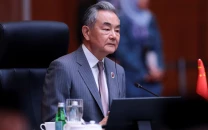Govt may use reserves to repay debt
Pakistan has to make large repayments that will keep default risks high

Moody’s Ratings has projected that Pakistan will draw its foreign exchange reserves to repay the maturing foreign debt, which will keep near-term default risks high.
“Argentina, Pakistan and Tunisia have large market debt repayments over the next two years compared to their foreign exchange reserves. Barring new or additional foreign currency financing from development partners, these sovereigns will likely use their foreign exchange reserves to repay debt. This will reduce their foreign exchange liquidity buffers and keep near-term default risks high,” the global rating agency said in a report published earlier this week.
The agency added that the significantly large interest payments would leave almost no fiscal space with the government to absorb any shocks.
It noted that the Pakistani government was actively engaged with the International Monetary Fund (IMF) to secure a new loan programme after the standby arrangement of $3 billion concluded in April 2024.
Pakistan’s foreign exchange reserves, held by the State Bank of Pakistan (SBP), rose $16 million and settled at $9.11 billion in the week ended May 31, 2024, the central bank said in its latest weekly update.
The reserves, however, remain lower when compared with the maturing foreign debt of $10 billion, which is required to be repaid by the end of July 2024, according to the central bank data.
Authorities, however, may be able to get rolled over a maximum part of the debt, leaving a small portion to be financed through forex reserves or by securing new loans.
Prime Minister Shehbaz Sharif is on an official visit to China, the world’s second largest economy, where announcements of new investment by Beijing under the China-Pakistan Economic Corridor (CPEC) and for the provision of fresh loans cannot be ruled out.
Moody’s Ratings gave an impression that the significantly high interest rate in global markets would not let Islamabad opt for commercial borrowing to finance debt repayments. It also did not expect the US central bank to cut its key rate soon.
Two global banks – the Canadian central bank and the European Central Bank – have made first cuts in interest rates in years by 25 basis points in the past two days. This suggests the US central bank will also go for reducing its rate soon, gradually making foreign debt affordable for emerging and frontier economies including Pakistan.
The rating agency anticipated that emerging economies like Pakistan may keep their interest rate high to attract foreign investment in the local currency-denominated government debt securities.
Pakistan’s central bank is scheduled to hold its monetary policy meeting on Monday (June 10) to review its policy rate. Financial markets expect a rate cut of up to 200 basis points to 20%.
The bank had maintained the rate at a record high of 22% for the past 11 months despite a deceleration in inflation and positive real interest rate.
Improved risk appetite will keep credit spreads (interest rate) relatively tight and allow most EM (emerging market) sovereigns to refinance the upcoming market maturities at affordable rates.
“However, spreads remain prohibitive for some low-rated sovereigns with sizable market repayment needs, like Argentina, Pakistan and Tunisia. This means they will continue to draw on their foreign exchange reserves, keeping near-term default risks high,” Moody’s reiterated.
Spreads exceed 600 basis points – implying dollar borrowing costs “that would likely exceed 10%” – for Argentina, Bolivia, Cameroon, Ecuador, El Salvador, Gabon, Pakistan, Tajikistan and Tunisia.
Higher-for-longer interest rates will aggravate difficulties for EMs, which struggle to afford debt. Although markets expect the US Fed to begin cutting rates this year, inflation and labour market dynamics threaten to keep rates higher for longer.
“This would further weaken debt affordability for EMs like Egypt, Kenya, Nigeria and Pakistan, where we expect interest payments to continue to absorb a large share of their revenue.”
Some sovereigns, including Egypt and Pakistan, have attempted to lengthen their debt maturities and reduce their exposure to interest rate risk. However, this is difficult to do in a high interest rate environment.
It will also take time, unless domestic markets are deep, with long-term investors like pension or social security funds and insurers, because other domestic creditors like banks have less appetite for longer maturities.
Interest payments of Bahrain, Egypt, Nigeria and Pakistan are likely to exceed a third of their total revenue in 2028. For Egypt, Nigeria and Pakistan, higher-for-longer interest rates would result in a further reduction in the already limited budgetary resources to respond to shocks or spend on longer-term credit enhancing policies, including building resilience to climate shocks and carbon transition risks and strengthening social safety nets.
Published in The Express Tribune, June 7th, 2024.
Like Business on Facebook, follow @TribuneBiz on Twitter to stay informed and join in the conversation.



















COMMENTS
Comments are moderated and generally will be posted if they are on-topic and not abusive.
For more information, please see our Comments FAQ